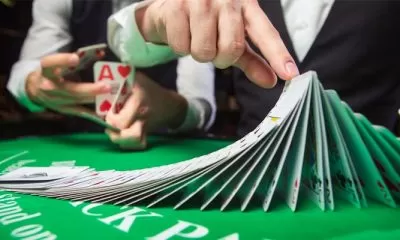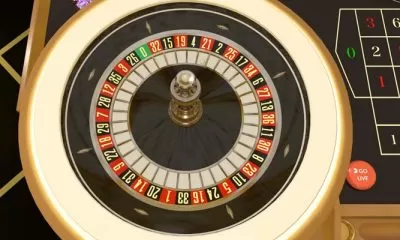Casino
Use Blackjack Strategy Charts for a Blackjack Win!
Published
9 months agoon
By
Sam Jonson
Millions of individuals engage in blackjack, whether it’s at physical casinos or through online gambling platforms. The game is designed with straightforward rules to appeal to casual players and intricate gameplay elements to captivate seasoned enthusiasts.
Many newcomers often assume that the primary aim is to get as close to 21 as possible without exceeding that number. While this is technically correct, the ultimate blackjack objective is to outperform the dealer while also aiming to achieve a blackjack hand. Achieving this goal often requires players to make challenging decisions that significantly impact their gambling experience.
Once the players have developed a solid understanding of the fundamental rules of blackjack, they should move on to acquiring the knowledge and strategies necessary to enhance their odds of winning.
Veteran players are typically well-versed in these steps, but those embarking on their blackjack journey may require guidance. This is where black jack charts prove invaluable. To gain insight into the various types of blackjack charts and tips to utilize them effectively, refer to the following blackjack guide.
Strategy charts Blackjack
Blackjack charts are helpful tools players aiming to optimize their decisions during the game often use. These charts provide a clear and structured reference for every possible combination of player hands and dealer upcards.
By consulting the chart, players can make informed choices, such as when to hit, stand, double down, or split. This systematic approach minimizes errors and increases the probability of making strategic moves that align with the game’s statistical probabilities.
In short, black jack strategy charts serve as a reliable roadmap for players, enhancing their chances of making more profitable decisions and improving their long-term success in the game.
However, note that while tools like charts can provide guidance, they cannot guarantee a victory. Therefore, it’s crucial to view them as a starting point and then develop your unique style of play.
By incorporating these tools into your foundation and adapting strategies based on your understanding of the game and your personal preferences, you can become a more versatile and successful blackjack player over time.
Learn and practice blackjack rules and how to play blackjack repeatedly. Ultimately, blackjack is a game that combines both science and art and finding your own approach can be the key to success.
Single deck basic strategy chart

In single-deck blackjack, as the name implies, a solitary deck of 52 cards is employed. This particular variant is favored by novices and casual players due to its lower house edge, which stands at a mere 0.16%, compared to other versions.
The chart is designed with your hand represented on the left vertical edge, and the dealer’s upcard is indicated along the top. In the chart, the letter ‘A’ signifies an ace.
Tips
- While adhering to the table’s guidelines is straightforward, being aware of a few strategic insights can elevate your performance.
- For example, when the option to double down after splitting is permitted, it expands your opportunities for splitting hands. Many players seize the chance to double down, leading to a more assertive style of play when this choice is available.
- Furthermore, among all blackjack variations, single-deck blackjack boasts the lowest house edge, particularly in games where the dealer hits on Soft 17 (0.19%) and allows for the resplitting of aces (0.16%).
- It’s essential to note that not all single-deck blackjack versions offer the same payouts. While most adhere to the 3:2 payout ratio, some games opt for less favorable 6:5 odds, which increases the house edge by 1.4%. Opt for games with a 3:2 payout ratio, whether you’re playing at brick-and-mortar or online casinos.
- Lastly, consider seeking out a single-deck game where the dealer stands on Soft 17 and allows doubling after splitting. Such variants are relatively rare in land-based casinos due to the advantage they provide to players. However, you may encounter this favorable version at select online casinos catering to US players.
Double deck basic strategy chart
In contrast to traditional blackjack, which typically employs 4 to 6 decks, double-deck blackjack utilizes just two decks. Similar to the previous chart, the vertical column on the left represents your hand total, while the top row showcases the dealer’s upcard.
Tips
- Much like single-deck games, most casinos adopt a 6:5 payout structure for double-deck blackjack, which tilts the house advantage in their favor. Nevertheless, a few establishments and online gambling platforms still provide games with a 3:2 payout ratio, though they may require some diligent searching to locate.
- The house edge in 3:2 double-deck blackjack fluctuates depending on the specific rules in play. For example, the most favorable house edge (0.14%) emerges in variations where the dealer stands on Soft 17, and players are permitted to double down after splitting, as well as resplit aces or exercise late surrender.
- Conversely, the least advantageous house edge (0.54%) is observed in blackjack variants where the dealer hits on Soft 17, and players are restricted from doubling down after splitting. It’s essential to assess both the house edge and payout structure before joining a game, as these factors significantly impact your choice of strategy.
Here are some valuable pointers for navigating double-deck blackjack.
- A duo of 5s is treated as a hard 10 hand, according to the chart.
- It’s always advisable to stand when you have a pair of 10s.
- In cases where splitting isn’t permitted, treat the pair as a hard hand. However, if you have a pair of aces in this situation, consider it a soft hand.
- If the game doesn’t allow resplitting aces but permits drawing after splitting, consider doubling down when the dealer’s upcard is a 5 or 6; otherwise, opt to hit.
Multi-deck blackjack strategy charts (4 to 8 decks)
The majority of casinos offer multi-deck blackjack as their standard option. Typically, this game employs six decks, although variations with four or eight decks can also be found.
In contrast to single/double-deck blackjack, multi-deck variants introduce a more significant number of ten-value cards into play, expanding the opportunities for achieving a blackjack.
Nevertheless, in multi-deck blackjack the house edge tends to be higher, which explains why most casinos favor it over the above alternatives.
Blackjack tricks
- If you are wondering how to win at blackjack, then continue to read…
- Casinos commonly offer six decks shoe-dealt blackjack, although eight-deck options are also quite prevalent. However, four-deck variations have become less common in recent times. Just like in other versions, it’s advisable to seek out blackjack games that pay 3:2 rather than those with a 6:5 payout ratio.
- The house edge in blackjack can significantly fluctuate depending on the number of decks in play. For instance, the lowest house edge (0.35%) in four-deck blackjack is typically found in games where the dealer stands on Soft 17, and players are allowed to double down after splitting.
- On the other hand, a six-deck game with the same favorable rules, including resplitting and late surrender, boasts a slightly lower edge (0.26%). In contrast, eight-deck blackjack, featuring a dealer who hits on Soft 17 and permits players to double after splitting, carries the highest house edge at 0.65%.
To enhance your performance in multi-deck blackjack, consider the following strategies.
- Commit to memory a specific multi-deck strategy, such as the one applicable when the dealer stands on Soft 17. Mistakes in this game can be more costly, so mastering a single approach will help minimize losses.
- When there are restrictions on splitting and resplitting, it’s advisable to treat your hand as a hard total unless you hold a pair of aces.
- In situations where resplitting a pair of aces is not allowed but drawing after splitting aces is permitted, opt to double down when facing a dealer’s upcard of 6; otherwise, take a hit.
- Refrain from standing on a stiff hand, typically valued between 12 and 16, as the presence of multiple decks increases the likelihood of receiving a low-value card.
Keep in mind that the dealer has a higher chance of obtaining a blackjack in a multi-deck game.
Key takeaways of basic strategy blackjack
To help you become familiar with the black jack basic strategy table, you can extract key principles and integrate them into your gaming sessions immediately.
Stand on 17 or higher
The primary blackjack rule is to stand on a hard 17 or any hand with a higher total. Although the dealer’s visible card is an Ace or a 10, it’s advisable to maintain your current hand rather than attempting to improve it further, given the limited number of beneficial cards.
Double down on 11
A hard 11, composed of your initial two cards, represents one of the strongest starting hands in blackjack. You can maximize your advantage by doubling down, thus enhancing your prospects of further wins.
Split 8s and Aces
Always consider splitting an ace or eights pair as your initial hand, irrespective of the dealer’s face-up card, even though it entails an additional wager. A similar strategy applies to nines, with the exception that it’s preferable to stand when the dealer shows a 7, 10, or Ace.
Never split 10s
In accordance with basic strategy blackjack, it’s best to stand when dealt a pair of 10s. Holding a total of 20 provides you with an excellent chance of winning the hand.
Hit on Ace-7 against dealer’s 9, 10, or Ace
Although Ace-7 can be a strong starting hand, it’s advisable to hit if the dealer’s upcard is greater than 8. The dealer is likely to form a more substantial hand than 18, which is why you should do this.
Only stand with 12 against dealer’s 4, 5, or 6
In this situation, it’s optimal to stand only when the dealer reveals a 4, 5, or 6. Else, the right move is to hit because the dealer’s hidden card is likely to result in a hand stronger than 12.
Stand with 13, 14, 15, or 16 against dealer’s 2 through 6
These hands frequently occur in blackjack, and it’s essential to understand how to handle them. As a general guideline, stand if the dealer’s upcard is 2, 3, 4, 5, or 6. If the dealer’s face-up card is higher, it’s advisable to hit and attempt to enhance your hand. When surrender is an option, consider using it when holding a 16 against a dealer’s 9, 10, or Ace.
How do you remember and recall the blackjack table?
Memorizing the blackjack strategy basic chart can be accomplished by breaking it down into manageable sections and practicing regularly. Start with fundamental rules like always standing on 17 or higher and never splitting 10s. Focus on specific hand values, such as 11 and 12, and understand when to double down or hit.
Work your way through the chart systematically, committing each decision to memory. Utilize flashcards, repetition, and visualization techniques to reinforce your recall. Additionally, practice with online blackjack games or simulate scenarios to apply the chart’s principles in actual gameplay. Consistency and patience are vital to mastering the blackjack strategy chart over time.
Blackjack, how to win?
To increase your chances of winning at blackjack, consider these four crucial tips –
1. Master basic strategy for blackjack
Learning and applying basic blackjack strategy is fundamental. This strategy chart prescribes the optimal moves for various player hands and dealer upcards. Following it diligently significantly reduces the house edge, giving you an advantage.
2. Stay in control of the bankroll
Set clear betting limits and adhere to them. Establish a budget for your blackjack sessions, and don’t chase losses as much as possible. Ensure you have enough funds to withstand losing streaks while also knowing when to walk away with your winnings.
3. Select the right table
Seek out games with favorable rules, such as those paying 3:2 for blackjack and where the dealer stands on soft 17. Avoid tables with unfavorable conditions like 6:5 payouts.
4. Card counting (advanced)
If you’re an experienced player and in a casino that permits it, consider learning card counting techniques. These methods involve keeping track of high and low-value cards in the deck, providing insights into when to increase your bets.
Blackjack, like other betting games, involves both skill and luck. There are no 100% wins, but by following the above strategy of blackjack tips, you can tilt the odds in your favor and enhance your overall gaming experience!
You may like
-
High Low Game: How and Why to Play, Variations, and Strategies
-
Decoding Baccarat: A Beginner’s Guide to the Game
-
Live Speed Baccarat: Game Rules, How to Play, and Strategies
-
A Comprehensive Guide to Play Poker Online with Friends
-
How to Play Roulette: Everything You Need to Know about Casino Roulette Game
-
Play Online Roulette Successfully: 6 Proven Strategies to Help You Win













